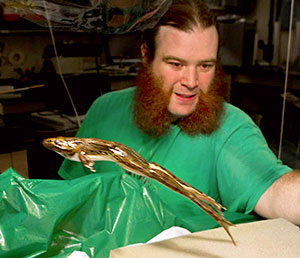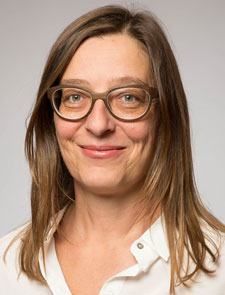The University of Akron’s Biomimicry Research and Innovation Center (BRIC) is dedicated to innovation inspired by nature. Meet three ¿ºýºôæâÚ researchers who are investigating nature to advance society.
Henry Astley

Henry Astley
Henry Astley’s research focuses on the biomechanics of animal movement, connecting biology and physics to study the processes animals must use to traverse their sometimes complex environments. His focus is on snakes, frogs and early tetrapods.
How can what we learn from the systems of reptiles, amphibians, and tetrapods?
A key concept of comparative biology is that certain animals can be ideal for testing certain principles, because those principles are of exceptional importance in those species.
For example, many frogs have a "spring-loaded" jump, similar to a catapult, which relies on elastic tendons, and so frogs are ideal for studying the interaction between physiology and morphology, specifically how the different configurations of muscles, bones and tendons can produce the modest hop of a toad or the exceptional leap of a tree frog.
Another example is the movement of snakes, which is at the intersection between their unique forms and the predominance of environmental influences for an animal which slides along the ground.
And the movements of the first vertebrates to crawl out of the water, the early tetrapods, show how the interactions between morphology, behavior and environment can influence a crucial and dramatic evolutionary transition.
How can these learnings improve our world?
Understanding the mechanics of animal movement can give us insights into fundamental evolutionary questions, but also allow us to build prosthetic limbs and robots which can mimic the strategies of animals.
 A prosthetic leg designed with insights from frog jumping may allow better acceleration, while robotic snakes can slither through tiny gaps in the rubble after an earthquake to hunt for survivors and amphibious robots can monitor shallow waterways.
A prosthetic leg designed with insights from frog jumping may allow better acceleration, while robotic snakes can slither through tiny gaps in the rubble after an earthquake to hunt for survivors and amphibious robots can monitor shallow waterways.
What aspect of nature are you currently researching?
I am currently working on underwater walking, how crabs or salamanders walk along the bottom, which is widely thought to have preceded the ability to walk on land. By combining insights from numerous species, I hope to both understand this sparsely-studied behavior and to replicate it in a robot. I am also continuing my work on snake locomotion, including sidewinding and arboreal locomotion, and frog jumping, in each case with plans to study both the biological and robotic implementations of these behaviors.
Petra Gruber

Petra Gruber
Petra Gruber is an architect with a strong interest in inter- and transdisciplinary design. Apart from her professional work as an architect she gained a Ph.D. in Biomimetics in Architecture in 2008 from the Vienna University of Technology in Austria.
As an architect, how did you first discover the benefits of biomimetic in design?
I was always interested in both Biology and Design, and felt fortunate when I discovered the field of Biomimetics to integrate both disciplines. I first started to work with bioinspiration in my diploma thesis in architecture, learning about the works of Frei Otto in Germany and research on Biology and Building.
Can you give an example of a system/solution found in nature that has led (or could lead) to innovation in architecture?
The self-cleaning or Lotus-effect that was discovered in the 1980s is a good example of an extremely successful biomimetic transfer, having led to hundreds of products with this function in different technical contexts. In the building industry, self-cleaning is applied to a wide range of surfaces of glass and facade materials. The development of that principle was a so-called solution-based approach, leading to a technology that is applicable to a wide product range.
What aspect of nature are you currently researching?
We are researching aspects of space and spatial structures in Biology, and how they relate to specific functions that are transferable into technology in terms of structural design or thermal properties. We are also applying tools from architecture and the arts to scientific research questions in order to establish new ways to investigate and explore biology, and reinterpret findings into new technological and artistic solutions.
What are you most excited about related to the work of ¿ºýºôæâÚ’s Biomimicry Research and Innovation Center?
I am most excited about the opportunity to work with a continuous group of people in an interdisciplinary setting, hoping to further the field of biomimetics into yet uncharted territory.
Hunter King

Hunter King
From 2012 to 2016, King worked as postdoctoral scholar in Prof. L. Mahadevan’s group at the School of Engineering and Applied Sciences at Harvard University, where he investigated termite mound ventilation. His focus is on the mechanics of biologically engineered structures and non-equilibrium and soft matter physics.
Can you give an example of what we can learn from the way termites construct their mounds?
There is much we still need to understand about the construction process, which is done synchronously by thousands of blind workers with no blueprints and no central decision-making authority. We have, however, learned a bit about the function of the termite mound, which appears to act as an external lung, exchanging metabolic gases from the nest with the environment.
Within the termite mound design, the engineering principle that surprised me the most was the passive derivation of useful work (in this case ventilation) from daily *oscillations* in ambient temperature. This emergent strategy seems notably different from those of typical human engineering, in which work is harnessed from the unidirectional flow of energy through a system.
What other biologically engineered structures have you studied/can we learn from?
We are beginning to investigate biological structures that capture fog and particulate matter from the wind, and the mechanism by which disordered, non-cohesive sticks can be formed into a rigid bird nest.
What are you most excited about related to the work of ¿ºýºôæâÚ’s Biomimicry Research and Innovation Center?
I am very excited about the opportunity to position my research between disciplines, taking advantage of local expertise in both the richness and complexity of biology, materials manipulation and characterization of polymer science, and creative development in design. There is so much for me to personally learn, and I believe the combined efforts of the diverse community will benefit all those involved.
ABOUT BRIC
The University of Akron Biomimicry Research and Innovation Center (BRIC) is a center dedicated to the advancement of innovation inspired by nature. Together with regional partners, the Center is building an internationally recognized center for biomimicry research, design, teaching and training.
The work of BRIC is to align the creative ideas of scientists, engineers, artists, and entrepreneurs to catalyze invention. By partnering our existing biomimetic research expertise with the Great Lakes Biomimicry (GLBio) business leaders, the BRIC paradigm lays the foundation for sustainable economic and educational innovation powered by nature-inspired technologies.
Principal Investigators are Drs. Ali Dhinojwala, professor of polymer science; Matthew Kolodziej, professor of art; Christopher Miller, associate professor of civil engineering; and Peter Niewiarowski, professor of biology.
.
